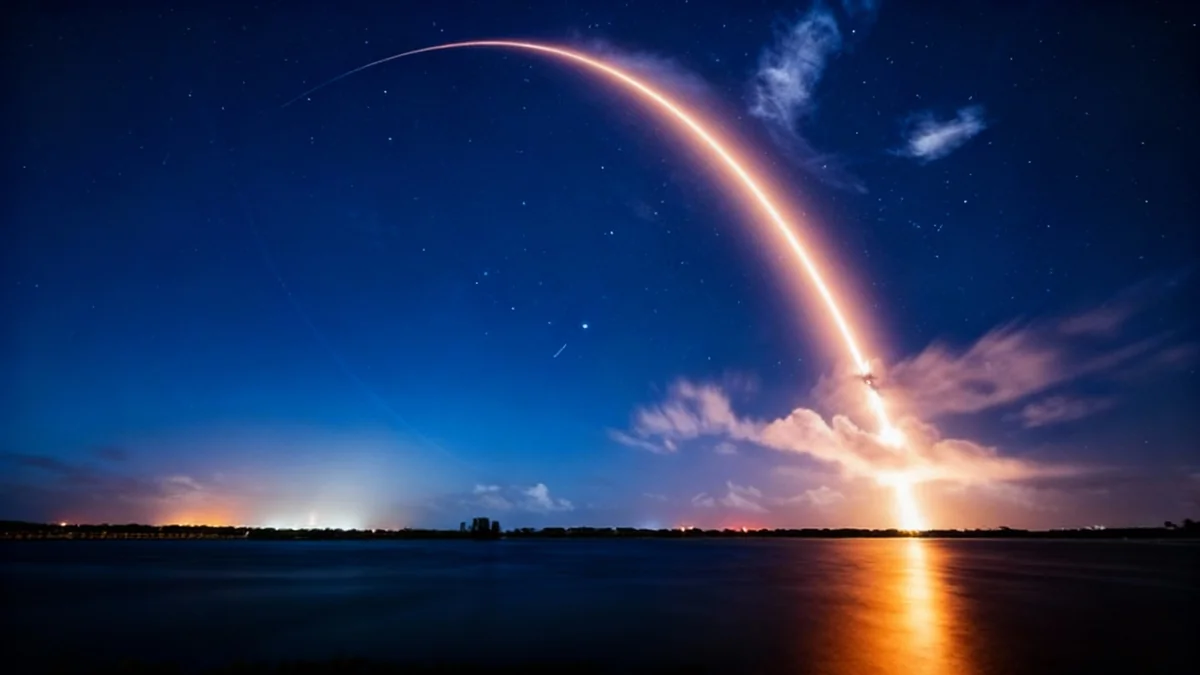Chinese commercial space company Orienspace has successfully completed the second launch of its Gravity-1 rocket, the most powerful solid-fuel launch vehicle in the world. The rocket lifted off from a mobile sea platform in the Yellow Sea on October 10, 2025, successfully deploying three satellites into their designated orbits.
The mission marks another significant step for Orienspace and China's rapidly expanding commercial space sector. This second successful flight demonstrates the reliability of the Gravity-1 rocket and the viability of sea-based launch operations, which offer greater flexibility and safety for orbital missions.
Key Takeaways
- Orienspace's Gravity-1 rocket successfully launched for the second time on October 10, 2025.
- The launch occurred from a ship in the Yellow Sea, highlighting China's sea-launch capabilities.
- The rocket deployed one wide-field satellite and two experimental spacecraft into orbit.
- Gravity-1 is currently the world's most powerful solid-fuel rocket, capable of carrying 6,500 kg to low Earth orbit.
- The company is developing larger, more powerful rockets, Gravity-2 and Gravity-3, for future missions.
Mission Details and Successful Deployment
The launch took place at 10:20 p.m. Eastern Daylight Time on October 10, which corresponds to 10:20 a.m. Beijing time on October 11. Video footage released by state broadcaster CCTV captured the dramatic liftoff, showing the rocket ascending through a hazy sky, propelled by massive plumes of exhaust.
The primary objective of this mission was to deliver a payload consisting of three separate spacecraft into low Earth orbit (LEO). According to official reports, the payload included one wide-field satellite and two smaller experimental spacecraft. All three were successfully placed into their intended orbits, confirming the mission's success.
This flight builds on the success of Gravity-1's inaugural launch in January 2024. That first mission also launched from the same mobile sea barge and carried three Yunyao-1 commercial weather satellites into orbit. Two consecutive successful launches are a critical milestone for a new launch vehicle.
The Significance of Sea Launches
Launching rockets from sea platforms offers several distinct advantages. It allows for launches from optimal locations on the equator to maximize Earth's rotational assistance, saving fuel. It also provides a wide range of launch inclinations and keeps launch corridors away from populated areas, significantly improving safety on the ground.
Understanding the Gravity-1 Rocket
The Gravity-1 is a formidable piece of engineering, designed for efficiency and power. Standing at approximately 100 feet (30 meters) tall, it is a multi-stage rocket designed to serve the growing market for satellite deployment.
Its design features a core stage, two upper stages, and four strap-on boosters. A key characteristic of the Gravity-1 is that all of its stages and boosters use solid-fuel propellants. Solid-fuel motors are known for their relative simplicity, stability for long-term storage, and ability to be launched on short notice.
Gravity-1 by the Numbers
- Height: 30 meters (approx. 100 feet)
- Propulsion: Solid-fuel motors for all stages and boosters
- Configuration: Three stages with four strap-on boosters
- Payload to LEO: 6,500 kilograms (approx. 14,300 pounds)
This powerful configuration allows the Gravity-1 to lift a substantial payload of 6,500 kilograms to low Earth orbit. This capacity makes it suitable for deploying large satellite constellations, a major focus of the global commercial space industry.
Orienspace's Future Development Roadmap
While the Gravity-1 is a significant achievement, Orienspace has even larger ambitions. The company is actively developing its next generation of launch vehicles, the Gravity-2 and Gravity-3, which are designed to carry much heavier payloads and compete in a different class of the launch market.
The Gravity-2 and Gravity-3 Rockets
The upcoming rockets will move away from an all-solid design and incorporate liquid-fuel technology, which offers greater control and efficiency for larger missions. According to reporting from SpaceNews, the designs for these vehicles are well underway.
- Gravity-2: This rocket will feature a liquid-fuel core stage combined with solid rocket boosters. Its projected payload capacity to LEO is approximately 25.6 tons, placing it in the heavy-lift category.
- Gravity-3: This will be a super-heavy-lift vehicle. Its design is expected to use three Gravity-2 core stages strapped together, similar to the architecture of SpaceX's Falcon Heavy. This configuration will increase its payload capacity by an additional 5 tons over the Gravity-2.
The development of these rockets signals Orienspace's intent to become a major player in the global launch services market, capable of handling a wide range of missions from small satellite constellations to large space station modules.
China's Growing Commercial Space Sector
The success of Orienspace is part of a broader trend within China. The country has been actively fostering a commercial space ecosystem, with numerous private companies emerging to compete in launch services, satellite manufacturing, and space applications.
Companies like Orienspace, LandSpace, and i-Space are making rapid progress in developing and launching their own rockets. This commercial expansion complements China's state-run space program, creating a more dynamic and competitive domestic industry.
The continued success of vehicles like Gravity-1 demonstrates the increasing maturity and capability of China's private space companies as they aim to capture a larger share of the international launch market.
With a proven rocket in Gravity-1 and a clear roadmap for more powerful vehicles, Orienspace is positioned to be a key contributor to this growth. Its focus on both solid and liquid-fuel rockets, along with its innovative use of sea launch platforms, showcases a flexible and forward-looking strategy.





